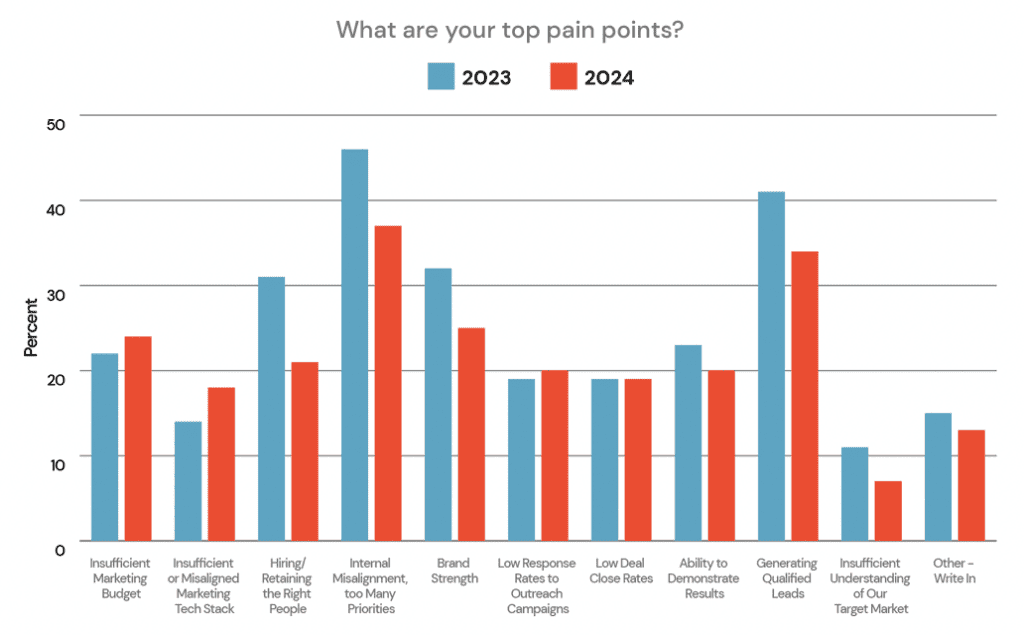
The Top 5 Pain Points of Today’s Supply Chain Marketer
As marketing professionals in the perpetually shifting supply chain industry, change is our constant companion. But with change inevitably comes new challenges.
To steer through the turbulence and chart the clearest path ahead, it is essential we keep a pulse on the pain points testing our industry. Virago Marketing’s 2024 Supply Chain Marketing Industry Outlook and Trends Report has identified 5 priority trouble areas currently facing supply chain marketing:
- Internal misalignment
- Lead generation
- Brand strength
- Insufficient marketing budget
- Hiring/retaining talent
By acknowledging and confronting these challenges now, we can break through barriers and unlock pathways to sustainable success.
In this blog, we’ll take an honest look at what’s broken, the issues these hotspots are causing, and actionable solutions to overcome them.
Cause & Effect: Combatting Marketing Challenges

Internal Misalignment
Issues It Causes:
- Miscommunication/different understanding of target audience and messaging: Without clear communication, marketing and sales teams may have different interpretations of who they are going after as prospects, resulting in inconsistent or ineffective messaging.
- Confusion around marketing qualification criteria: Sales and marketing may define marketing qualified leads differently, resulting in unqualified leads being passed to sales.
- Siloed goals: If sales, marketing, and the C-suite don’t have the same goals, collaboration becomes a challenge. Leaders create and perpetuate inefficiencies in achieving objectives as each team works toward their own set of KPIs.
- Poor content quality: Lack of alignment can lead to the creation of content that fails to resonate with the intended audience – wasting time and money.
Solutions:
- Agree on ideal customer personas: Establish a shared understanding of the target audience to align marketing and sales efforts.
- Document lead qualification criteria: Create a shared definition aligned to the buyer journey to ensure marketing passes fully nurtured leads to sales.
- Set KPIs/goals together: Collaboratively define key performance indicators and goals to ensure all teams are working toward common objectives.
- Develop a customer journey map: Map out the customer’s journey and create content that guides prospects seamlessly through the sales funnel.
- Regular team meetings: Foster regular communication to address challenges, share insights, and maintain a cohesive approach that keeps everyone on the same page.
Aligning marketing, sales, and management teams is crucial. According to LinkedIn’s Art of Winning guide, a lack of coordination between these teams wastes an estimated $1 trillion annually. Companies that achieve alignment experience 36% more revenue growth and are 72% more profitable.
Lead Generation Concerns
Issues It Causes:
- Low-quality leads impacting sales numbers: Ineffective lead generation strategies can result in a lower quality of leads, junking up your CRM database and negatively affecting overall sales performance.
- Missed KPIs: Failure to generate quality leads can lead to the missing of key performance indicators (KPIs) critical for assessing marketing and sales success.
- Reduced marketing budget/team: Poor lead generation can lead to management questioning the importance and effectiveness of marketing, which can, ultimately, result in cutting budgets and team resources.
- Overreliance on outdated strategies: Focusing too heavily on older inbound tactics versus modern account-based marketing approaches may limit quality lead pipeline
Solutions:
- Create targeted content for specific audiences: Tailor content to resonate with the unique needs and interests of different audience segments. This can include segmenting emails accordingly, boosting social media posts to specific audiences, tagging blogs by topic or audience, and creating multiple sell sheets for each audience segment.
- Nurture leads: Implement lead nurturing strategies to guide potential customers through the buyer’s journey.
- Use incentives for form fills/engagement: Encourage engagement by offering incentives for providing information, thus improving lead quality.
- Employ marketing automation tools: Leverage automation to streamline lead generation processes and enhance efficiency.
- Develop case studies or customer testimonials: Showcase success stories to build trust and credibility among potential customers.
- Employ ABM strategies: Identify key target accounts and coordinate touchpoints to penetrate multiple buying group contacts per account.
Effective lead generation is paramount for sustained growth. Crafting audience-specific content and utilizing automation tools can significantly impact the quality of leads and boost overall performance and efficiency. A recent Pedalix report found that 64% of B2B companies say marketing automation improves the efficiency of all processes.
Brand Strength (or Lack Thereof)
Issues It Causes:
- Sales are hindered by inconsistent messaging, confusing potential customers, and diminishing sales efforts.
- Lack of trust in the brand: Inconsistency erodes trust, making it challenging for customers to establish a strong connection with the brand.
- Talent challenges: A weakened brand may struggle to attract and retain high-caliber talent.
- Diminished marketing ROI: Inconsistent branding can dilute the effectiveness of marketing efforts, impacting return on investment.
Solutions:
- Develop a unique brand identity: Clearly define the brand’s values, mission, and personality to differentiate it from competitors.
- Ensure consistency in messaging across all employees: Train and align all employees with the brand message to maintain a cohesive external image.
- Promote the brand where the target audience resides: Strategically position the brand in channels and platforms frequented by the target audience.
A strong brand is the cornerstone of success. Consistency in messaging and strategic promotion are vital for establishing trust, attracting talent, and maximizing marketing ROI.
Insufficient Marketing Budget
Issues It Causes:
- Lack of effective tools: Working with a small or insufficient budget may limit access to essential marketing tools and technologies.
- Diminished ROI: A reduced budget can lead to decreased return on investment for marketing initiatives. When financial resources are limited, marketers are forced to scale back campaign size, frequency, scope, and overall quality. Fewer touchpoints to engage potential customers result in lower lead and sales conversion rates.
- Limited promotion/publicity: Budget constraints may restrict the scope of promotional activities, resulting in reduced brand exposure.
Solutions:
- Carefully allocate the marketing budget: Prioritize activities that provide the highest return on investment (ROI) to maximize impact.
- Explore cost-effective strategies: Embrace social media marketing, content marketing, and email marketing for a cost-effective yet impactful marketing approach.
- Track and report on marketing performance: Demonstrate marketing impact through metrics like cost per lead or sales influenced to showcase ROI value, so that your top brass can start to view marketing as a revenue producer, not a cost center.
- Outline future growth potential: Build forecasts illustrating the additional revenue possible through expanded budgets to fund high-performing campaigns at a greater scale.
- Benchmark competitor spend: Compare marketing expenditure versus peers to evaluate appropriate budget size relative to the market.
Facing budget limitations requires both strategic prioritization of current marketing spend and compelling cases made to increase future funding. By carefully allocating existing budgets on high-ROI initiatives, embracing cost-efficient tactics, demonstrating marketing’s revenue value, and outlining goals for elevated budgets, teams can maintain engagement despite constraints while building the business case for the enhanced budgets imperative to drive growth.
Hiring/Retaining Top Talent
Issues It Causes:
- Lack of necessary skill sets: Inadequate talent acquisition may result in a team lacking the diverse skill sets needed for effective marketing.
- Loss of talent to competitors: Fierce competition may lead to the departure of valuable team members to rival companies.
- Employee burnout: Overworked teams, especially in the absence of necessary skill sets, can lead to burnout and decreased productivity.
- Poor succession planning: Lack of continuity planning for key roles could spur further churn from departing institutional knowledge.
Solutions:
- Personalize employee benefits through a data-driven approach: Understand the needs of individual employees to offer personalized benefits and foster satisfaction.
- Invest in training and development programs: Provide continuous learning opportunities to upskill existing team members and attract new talent.
- Focus on employer branding: Develop a positive and attractive employer brand to retain and attract top talent.
- Diversity and inclusion: Embrace diversity to build a well-rounded and innovative marketing team.
- Create clear career progression planning: Set expectations around career growth opportunities and advancement timelines to motivate employee development.
- Establish mentorship programs: Pair junior team members with experienced leaders to transfer institutional knowledge and ready the next generation.Digital marketing skills: Invest in enhancing digital marketing skills to stay ahead in the rapidly evolving landscape.
Providing high potential team members with personalized career plans, mentor pairing, and skills elevation demonstrates valued paths forward. This fuels retention by enabling continual advancement within the organization.
Are You Ready to Remedy Your Pain Points?
Combating these pain points in 2024 will be a challenge, but one you can undoubtedly achieve with the right mindset, plan, and team. By addressing these challenges and implementing strategic solutions, your company will not only overcome obstacles but also thrive in the competitive landscape of supply chain marketing.
Discover more information about these pain points and other industry trends in our 2024 Supply Chain Marketing Industry Outlook and Trends Report. You’ll find enlightening statistics about the industry’s top objectives, tactics being invested in, team and budget size, and more.
Interested in the Full Report?
Click the button below to access more information about the survey.



